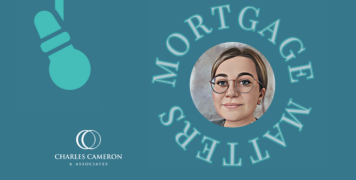Contact
020 4515 6728
info@ccameron.co.uk
Charles Cameron & Associates
Blackfriars Foundry
154-156 Blackfriars Road
London SE1 8EN
Mortgage matters
October 6, 2022
Information published was correct at the time of writing
Different types of mortgages explained

THERE ARE MANY factors to consider when choosing a mortgage, and the type of mortgage you choose will depend on your individual circumstances. In essence, all mortgages work in the same basic way – you pay back what you borrow, plus interest. The reason there are different mortgages on the market comes down to two main things: How interest is paid back and how interest is calculated.
Mortgages are made up of two parts:
- Capital (the money you borrow to purchase the property)
- Interest (the interest due to the lender on the amount you owe)
Repayment mortgage: This is the most common type of mortgage in the UK. With a repayment mortgage, you pay back both the capital (the amount you borrowed) and the interest on the loan each month. The amount of capital and interest you pay each month is usually fixed for an initial period, typically between two to five years. After this, your payments may increase or decrease depending on the terms of your mortgage.
The main advantage of a repayment mortgage is that it will eventually enable you to own your property outright, provided you keep up with the monthly repayments.
Interest-only mortgage: You only pay back the interest on the loan each month and not the capital. With an interest-only mortgage, you will need to find another way to repay the capital at the end of the mortgage term, typically through the sale of the property. At the end of the interest-only term, the borrower must repay the entire principal (the original loan amount) in one lump sum.
Interest-only mortgages were originally introduced for homebuyers who expected their incomes to increase significantly over time and who planned to sell their home before the end of the interest-only term. However, many borrowers found themselves unable to sell their home or refinance into a traditional mortgage when the time came to repay the principal. As a result, interest-only mortgages have become much less common in recent years.
HERE, WE TAKE A LOOK AT SOME OF THE MOST POPULAR TYPES OF MORTGAGES
Different mortgages suit different people for different reasons. There are many different types of mortgages available, and each one is suited to a different type of borrower.
Fixed rate mortgages: As the name suggests, a fixed rate mortgage has an interest rate that is set for a specific period of time, usually between two and five years. This means that your monthly repayments will stay the same during this time, even if interest rates rise. This can give borrowers peace of mind, as they know exactly how much they need to budget for each month. However, it is worth noting that once the fixed rate period comes to an end, the interest rate will usually revert to the lender’s standard variable rate, which could be a higher rate.
Tracker mortgages: A tracker mortgage is where the interest rate is set at a certain percentage above the Bank of England (BoE) base rate. For example, if the base rate is 1.5%, and your tracker mortgage has an interest rate of 3.5%, then your actual interest rate would be 5.0%. The big advantage of tracker mortgages is that they usually start off with a lower interest rate than fixed rate mortgages, so your monthly repayments could be lower. However, as with fixed rate mortgages, once the initial period ends (usually after two or five years), the interest rate will usually revert to the lender’s standard variable rate.
Discount rate mortgages: A discount rate mortgage is where the interest rate is discounted for an initial period, usually between two and five years. For example, if the lender’s standard variable rate is 4%, a borrower with a discount rate mortgage might only pay 3% interest for the first two years. After the initial period ends, the interest rate will usually revert to the standard variable rate.
Capped rate mortgages: A capped rate mortgage is similar to a tracker mortgage, in that the interest rate is set at a certain percentage above the BoE base rate. However, with a capped rate mortgage, there is a limit (or ‘cap’) on how high the interest rate can go, even if the base rate rises. For example: You take out a mortgage with a 1% discount and a cap at 4.5%. The standard variable rate is 5% at first, so you pay 4%. After a year, the lender raises its standard variable rate to 6%, so your new interest rate would change to 5%. However, the cap means you only pay 4.5%.
Offset mortgages: An offset mortgage is where your savings are offset against your mortgage balance, so you only pay interest on the difference. For example, if you have a mortgage of £100,000 and savings of £20,000, you would only pay interest on £80,000. Offset mortgages can be a great way to reduce the amount of interest you pay over the life of your mortgage, as well as helping you to clear your debt more quickly.
Don’t forget, our professional, friendly advisers are on hand to support you and can help you explore all of your options.



